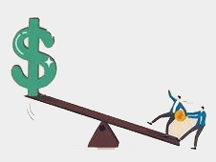What is margin and leverage in Forex trading?
The goal of leverage effect is to provide a higher return on investment, which makes this approach attractive to both large and retail traders.
Understanding margin and leverage
 The terms "margin" and "leverage" are often misunderstood by novice traders. Risk management is the key to success in financial sector operating, but it is only achievable when we correctly employ the leverage effect. Margin trading is applicable to a wide range of markets, including forex, commodities, futures, stock, and cryptocurrency. Its objective is to increase the return on investment. This is the reason which makes such approach attractive to both large (or institutional) and small (or retail) traders. In reality, these two terms indicate the same thing, but in a different way. The difference is that leverage is presented as a ratio (for example, 1:100) and margin as a percentage (or %). This is what causes confusion for most beginners, which does not allow them to fully comprehend and understand.
The terms "margin" and "leverage" are often misunderstood by novice traders. Risk management is the key to success in financial sector operating, but it is only achievable when we correctly employ the leverage effect. Margin trading is applicable to a wide range of markets, including forex, commodities, futures, stock, and cryptocurrency. Its objective is to increase the return on investment. This is the reason which makes such approach attractive to both large (or institutional) and small (or retail) traders. In reality, these two terms indicate the same thing, but in a different way. The difference is that leverage is presented as a ratio (for example, 1:100) and margin as a percentage (or %). This is what causes confusion for most beginners, which does not allow them to fully comprehend and understand.
Under the hood of financial leverage
The leverage ratio is expressed as follows:- 1:5
- 1:10
- 1:30
- 1:100
This ratio indicates the number of units that can be managed per unit of your account balance. This means that if your account balance is $1,000 and your leverage is 1:10, you can manage $10,000. Why can I manage $10,000 when I have only $1,000 in my account, you may ask. Well, 1:10 leverage means that you can control 10 units for each unit in your account, so your account has $1,000 units, and each can control an additional 10 units, resulting in a final result of $10,000. This example shows that the ratio shows the maximum amount that can be managed at a particular level of leverage. The more leverage you have, the more money you can manage. The easiest way to find the maximum amount you can trade is to multiply the amount in your account by the number of units you can manage with leverage.
The anatomy of margin
The margin percentage indicates the portion of the total value of the transaction that we need to fund on our own.
If our margin is 10% and the total value of the transaction is $1,000, we will open and maintain this position from the balance of our account with our own funds of $100. In this example, the value of the transaction is multiplied by the margin percentage to be $1,000x10%, i.e. $100 to open a $1,000 position. A reasonable question may arise: Where does the other $900 come from then? The answer is - this amount is provided by the broker. That's why it is so important to carefully choose forex broker.
The relationship between leverage and margin
As mentioned earlier, margin and leverage show the same thing. The reason is that each leverage ratio corresponds to a certain margin rate. To find this percentage, we need to divide the leverage ratio. Then we multiply by 100 and find the margin percent. For example, a leverage of 1:10 corresponds to a margin of 10%. Look at the table below, the greater the leverage we have, the lower the margin rate will be. Conversely, the lower the leverage, the higher the margin:
| Leverage | 1:5 | 1:10 | 1:30 | 1:100 |
| Margin | 20%* | 10% | 3.34% | 1% |
Leverage, margin and risk
There is a relationship between the use of the leverage effect and the risk in trading on the financial markets. The higher the load on the account, the greater the risk, which can have a negative impact on the balance, even with smaller price deviations. Many traders do not realize that the account can be debited not only from a larger position, but also from many smaller trades. For this reason, the total value of open positions should be carefully monitored, as margin trading can significantly increase your profits, but can also increase your realized losses.
Conclusion
The advantage of margin and leveraged trading is that if you pick right, you can win huge. The disadvantage is that if you pick wrong, you will lose huge. Also, you may be required to deposit additional capital to cover your margin. In fact, it's possible to lose more money than your initial investment when trading on margin. And, of course, the elephant in the room - an often overlooked quality of leveraged trading is that you'll owe interest on your position, called swap, and this interest depends on the size of the position and holding time - the longer you hold your position, the greater the interest will be.
Related article: Which are successful forex strategies?